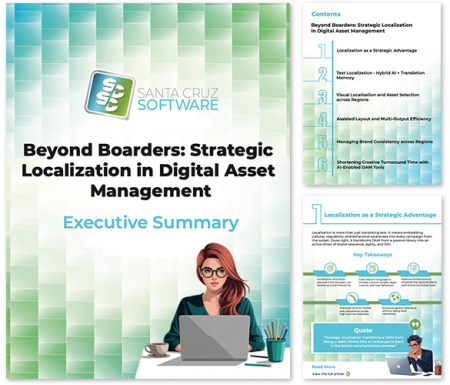
This article is the fourth installment in a six-part series on localization in Digital Asset Management (DAM), published weekly. Each article explores a different aspect of how global brands can balance consistency with local relevance. For those who want the full picture, we’ve created a free executive summary that includes key insights from the series as well as links to all upcoming articles before they are released.
Article Preview:
One of the most persistent anxieties among Brand Managers and Creative Directors is the risk of inconsistency when content is adapted across geographies. While localization is vital for relevance and engagement, it can also introduce variation that undermines the integrity of the brand. Fonts shift, colors change, tone drifts and (in the worst cases) entire messages are lost or distorted in translation. This is rarely the result of malice or negligence. More often, it is caused by the absence of proper controls and infrastructure to enable compliant localization at scale.
A mature DAM strategy must reconcile two seemingly opposing forces: the need for global brand consistency, and the equally pressing requirement for local relevance. This tension lies at the heart of most enterprise content governance challenges. The solution lies not in choosing one over the other, but in building systems that allow both to coexist.
The Pitfalls of Over-Centralization
Historically, many organizations attempted to enforce brand consistency through centralized control. Only a designated creative team (often headquartered in the organization’s home market) was permitted to produce content. While this approach preserved uniformity, it created bottlenecks, stifled agility and frequently resulted in tone-deaf content that failed to resonate in local markets.
In some cases, local teams circumvented the system altogether, which created ‘rogue’ assets that existed outside the DAM platform (with all the associated problems that this can entail). These off-brand materials were often more effective at connecting with local audiences but introduced serious risks in terms of brand coherence, compliance and legal exposure.
A better approach is to enable localization within defined boundaries. This requires a combination of tools, templates, permissions and cultural insight – all coordinated within the DAM framework.
The Building Blocks of Global Consistency
To manage brand consistency across regions without constraining local initiative, DAM systems should offer the following capabilities:
- Structured metadata frameworks: Assets should be tagged not only by campaign or channel, but also by brand element (e.g. core messaging, logo type, brand tone). This allows content to be reused and audited across markets.
- Template-based asset production: Layouts, color palettes, font choices and design motifs are embedded in templates, ensuring consistency even when the underlying content varies.
- Controlled vocabulary and taxonomies: Approved terminology (often linked to translation memory systems) reduces the risk of linguistic drift.
- Permission-based editing: Regional users can adapt content within pre-set boundaries, while central teams retain oversight.
- Audit logs and version tracking: Changes to content are tracked, enabling review and rollback if necessary.
- Multilingual brand guidelines: Documentation on brand tone, voice and visual identity should be available in all active languages, not just English.
These components enable a form of controlled flexibility. Regional teams have the autonomy to make content relevant, while brand leadership maintains confidence that the outputs remain within accepted standards.
Would you like an executive summary on this series?
Download an easy-to-scan free executive summary here with all the key information.

